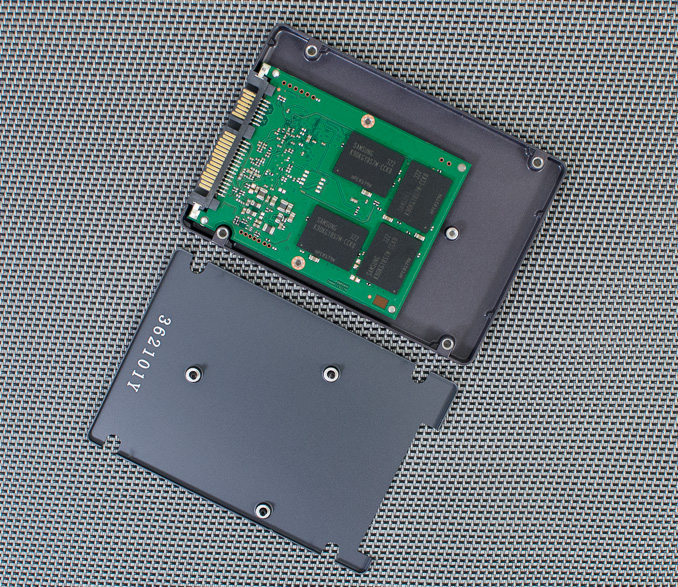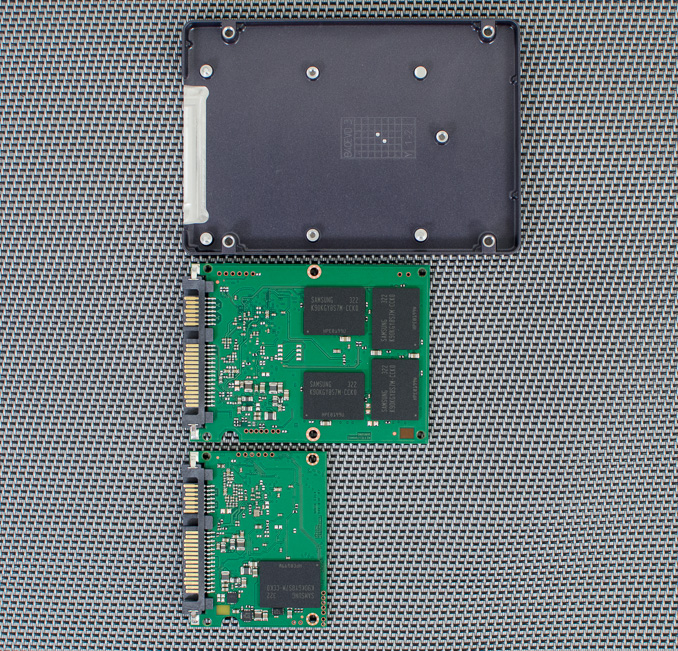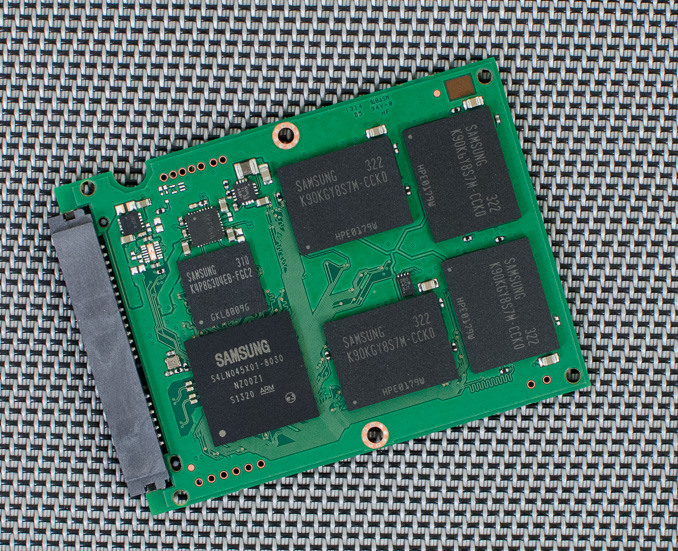Samsung SSD 840 EVO Review: 120GB, 250GB, 500GB, 750GB & 1TB Models Tested
by Anand Lal Shimpi on July 25, 2013 1:53 PM EST- Posted in
- Storage
- SSDs
- Samsung
- TLC
- Samsung SSD 840
Inside the Drives & Spare Area
The EVO is offered in a single form factor - 2.5" at a 7mm thickness. There are three torx (T5) screws that hold the chassis together, removing them gets you a look at the EVO's very simple internals. Surprisingly enough there's no thermal pad between Samsung's MEX controller and the chassis.
Samsung, like Intel, does a great job of reducing the number of screws and simplifying the assembly of its drives. I would prefer if Samsung didn't insist on using torx screws to hold the chassis together but I'm sure it does have some impact on reducing returns. There's also growing concern of counterfit SSDs which I guess screw choice could somewhat address.
There are two PCB sizes used in the EVO lineup, neither of which occupies the full volume of the 2.5"/7mm chassis. The 120 and 250GB drives use the smallest PCB, while the other drives use the larger layout. The larger PCB has room for 8 NAND packages, while the half length PCB can accommodate two. Each of the NAND packages can hold up to 8 x 128Gbit 19nm TLC die.
To deal with the realities of TLC, Samsung sets aside more of the drive for use as spare area on the EVO than it does on its MLC Pro line. Due to TurboWrite however, the percentage is actually a bit less than it was on last year's 840.
| Samsung SSD 840 EVO Memory | |||||||
| Advertised Capacity | 120GB | 250GB | 500GB | 750GB | 1TB | ||
| DRAM Size | 256MB LPDDR2-1066 | 512MB LPDDR2-1066 | 512MB LPDDR2-1066 | 1GB LPDDR2-1066 | 1GB LPDDR2-1066 | ||
| # of NAND Packages | 2 | 2 | 4 | 8 | 8 | ||
| # of NAND die per Package | 4 | 8 | 8 | 4 | 8 | ||
| NAND Capacity per Package | 64 GiB | 128 GiB | 128 GiB | 96 GiB | 128 GiB | ||
| Total NAND | 128 GiB | 256 GiB | 512 GiB | 768 GiB | 1024 GiB | ||
| Spare Area | 12.7% | 9.05% | 9.05% | 9.05% | 9.05% | ||
I've tossed internal shots of all of the EVO lineup into the gallery below:



















137 Comments
View All Comments
MrSpadge - Saturday, July 27, 2013 - link
Agreed: no real drive (read: not a rubbish sale) can touch the price of a 128 GB 840 here in Germany either.MamiyaOtaru - Friday, July 26, 2013 - link
hell with that I want SLCNotmyusualid - Friday, July 26, 2013 - link
Me too...Dal Makhani - Thursday, July 25, 2013 - link
why still a dealbreaker? Unless you write a TON. Its a great drive and you dont really need MLC.Heavensrevenge - Thursday, July 25, 2013 - link
The worries of TLC is a pretty useless worry. I still have a 32MB Sony flash stick I used around 2003, and its flash memory wasn't rated and wear-leveled like it does nowadays by design and It's not dead nor corrupted somehow lol. If you have a USB stick older than 5 years old or any flash cards for a camera that's a few years old and still working 100% fine when people weren't so uselessly worried about flash endurance, then these drive will pose no problems whatsoever.Oxford Guy - Thursday, July 25, 2013 - link
I thought the Vertex 2 firmware problems (especially the wake-from-sleep bug) were overblown until I had three of them die. I finally gave up on RMAs because the replacements died, too. Anandtech was so positive about OCZ and its Vertex 2. Funny how the drives didn't turn out to be so great. I don't remember the rave reviews covering the wonderful panic mode, either.HisDivineOrder - Saturday, July 27, 2013 - link
Lots of people were raving about OCZ back then. Today, it's clear. Friends don't let friends OCZ.Shadowmaster625 - Thursday, July 25, 2013 - link
Can you test RAPID by cutting power to a pc while doing normal everyday stuff like surfing the web or watching a youtube or loadign a game. I would like to know how likely it is for windows to have an unrecoverable error if it loses power while this cachign solution is active.Spunjji - Friday, July 26, 2013 - link
I second that request.MrSpadge - Saturday, July 27, 2013 - link
You'd need to be writing to the disk to provoke errors, not reading.